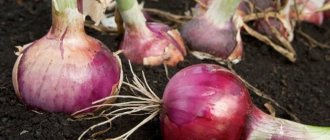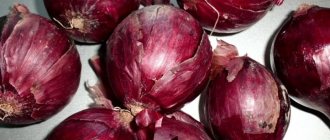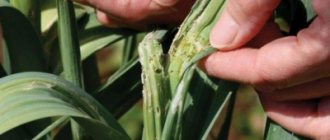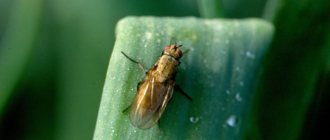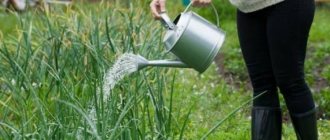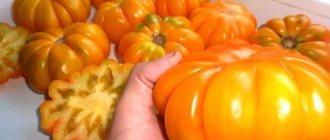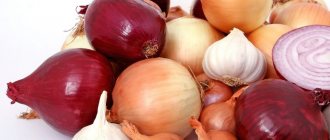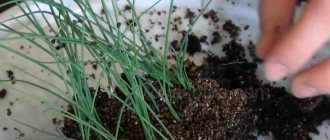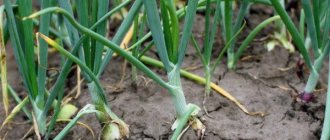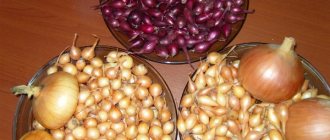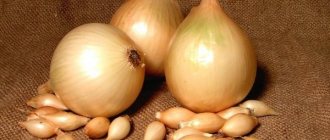Vegetable growing » Onions
0
2529
Article rating
Kira Stoletova
Chalcedony onion is an early ripening and high-yielding variety. It is unpretentious and can grow in any conditions. The plant can be planted with seeds or sets. You can grow onions both for your own needs and for commercial purposes. This variety has been receiving excellent reviews for years.
Onion Chalcedony
Description and characteristics of the variety
In the south of Russia, Chalcedony onions are grown from sets; in other regions, cultivation is carried out using the seedling method.
- An early ripening variety that ripens within 110 days after germination.
- On a square meter of bed you can grow up to 7 kg of vegetables.
- The fruits are stored without loss of quality for about 8 months.
- Cold resistant. Seeds of this variety germinate even at temperatures of 3-5 degrees Celsius. Onions grow best at 18-20 degrees Celsius.
- It is more profitable to grow onions from seeds directly to the bulb. This way you can get a rich harvest of larger bulbs. This is easy to do if you follow the rules of agricultural technology described below. First you need to grow seedlings.
- In the southern climatic zones it is sown with seeds in open ground, in the central regions and zones with a cool climate it is grown through seedlings.
- With the seedling method of growing, onions shoot less and have time to ripen even in harsh climates.
Advice! Many vegetable growers plant Chalcedony onions to force feathers.
Properties of onion Chalcedony
In addition to the attractive presentation and large size of the bulbs, the Chalcedony variety has other properties that are important for humans. Greens and vegetable heads have a beneficial vitamin composition, but in some cases they can cause harm to the body.
Benefit
Like other varieties, Chalcedony onions are characterized by the presence in the pulp of the fruit of vitamins B and C, calcium, zinc, iron, fluorine and manganese, as well as medicinal essential oils.
- Therefore, the bulbs of this variety have the following beneficial properties:
- stimulate metabolism and improve appetite;
- have low calorie content, so they can be included in the diet when losing weight;
- increase the level of hemoglobin in the blood and help fight anemia;
- have a beneficial effect on the functioning of the cardiovascular system;
- cleanse the body of toxins and waste;
- help cope with depression and normalize sleep;
- increase the body's immunity against colds.
Possible harm and contraindications
Despite the long list of beneficial properties, when consumed in large quantities, Chalcedony onions can harm the body.
- Its negative qualities include:
- the appearance of an unpleasant odor from the oral cavity;
- increased blood pressure;
- stomach discomfort;
- disturbances in the functioning of the heart;
- irritation of the mucous membranes of the upper respiratory tract, which can lead to an attack of suffocation.
It is strictly forbidden to use Chalcedony onions in the following cases:
- stomach ulcer or gastritis;
- heart disease;
- hypertension;
- asthma.
Important! Children can start giving onions only from the age of 8-9 months, adding it in small quantities to soups and vegetable stews.
Fruit characteristics
- Chalcedony - onions.
- The bulbs are round and large. Each weighs about 150 g and reaches 12 cm in diameter.
- The color is light brown with a faint bronze tint.
- The green feather of the onion stretches 16 cm in height. Inside is empty, juicy, with a slight bitterness.
- In cross section, the bulb is white with dense, fleshy and juicy scales.
- Contain vitamins B, C, A, PP, as well as iron, potassium, ascorbic acid.
- The taste is spicy but pleasant.
Useful tips
Experienced gardeners highlight several additional recommendations that also help to get a generous harvest of Chalcedony onions.
A list of these recommendations is presented below:
- good predecessors for onions are zucchini, pumpkin and cucumbers;
- It is not recommended to plant onions in an area where carrots, radishes or celery were grown last year;
- It is not recommended to use fresh manure as a fertilizer, as it will provoke the growth of green mass, but will make the bulb small;
- to grow seedlings, you can use fertile soil purchased in a specialized store;
- if, after planting seedlings in open ground, night frosts are observed, the sprouts should be covered with film;
- You can reuse the area for planting onions only after 3-4 years;
- if the plants in a row are located too closely together, they need to be thinned out to provide free space for the formation of large bulbs;
- To repel pests, you can plant marigolds, calendula or mustard around the perimeter of the garden bed.
Chalcedony onions are a versatile variety that can be grown for fresh greens and large, juicy bulbs. Using the growing recommendations and plant care rules listed in this article, you can achieve a high yield of beautiful and tasty vegetables.
Advantages and disadvantages
The biggest advantage of this variety is its:
- high yield.
The remaining advantages of the variety are no less important:
- resistance to low temperatures;
- excellent keeping quality;
- resistance to long-distance transportation;
- not susceptible to diseases;
- not demanding in care;
- grows well even in unfavorable weather conditions;
- not afraid of drought.
The only disadvantage is that you have to buy expensive seedlings for planting.
It can be recommended to beginners who want to grow turnips from nigella.
Seedling care
There is no need to use any specific techniques for seedlings. The main thing is to carefully water, lightly loosen the soil, and feed if necessary. For fertilizing, you can use humins or complex fertilizers. It is mandatory to provide additional lighting to the plants, this is especially important on cloudy days.
Water with settled water at room temperature, being careful not to get it on the green feathers of the young onions.
There should be no drafts or sudden temperature changes in the room. It is also important to ensure that the seedlings are not cold on the windowsills (this applies to both onion seedlings and all other plants).
The time for landing on the ridge is mid or late April, but everything is decided based on weather conditions. True, experts do not advise over-holding the seedlings, since later they will take root worse and get sick more.
Having determined the time of planting, ten days before, you can begin to harden the seedlings. A veranda, balcony, loggia, where windows and doors will be open, are suitable for this. After such procedures, the seedlings will be stronger, healthier and better adapted when planted in the beds.
It is better to plant seedlings on the ridge in the evening, the planting pattern is 25x25 cm, they are buried about 3 cm. After this, carefully water the soil and mulch. Humus or peat is suitable as mulch.
Features of cultivation
This variety of onion can be grown from seeds, sowing them directly into open ground in the southern regions, or you can use the seedling method.
Soil preparation
Chalcedony is not a fancy variety. According to crop rotation, it must be planted in the area where zucchini, pumpkin, tomatoes, potatoes, cucumbers, and cabbage were previously grown.
But after garlic, carrots, corn, onions are not planted. Also, it cannot be cultivated for two seasons in the same area.
For planting, choose an elevated place where water will not stagnate, since onions do not like waterlogging.
The bed is prepared in the fall. The soil is dug up, all weeds are removed and fertilized. It is best to add compost or humus at the rate of 3-4 buckets per 1 m2.
In the spring, 3-4 days before planting, add the following to the soil per 1 m2:
- 2-3 buckets of humus.
- 2 tbsp. spoons of superphosphate.
- 1 glass of ash.
If onions are planted for forcing feathers, then you need to add saltpeter. The bed is raised 15-20 cm above the level of the entire site; in wetlands, the height is increased to 25 cm. Next, the site is dug up, weeds are removed, loosened and watered.
Growing from seeds
Growing seedlings from seeds will require more time and effort, but this method will allow you to get a turnip in one year, even in risky farming areas.
Seeds for seedlings are sown in the last week of February - early March. The age of seedlings when planted in open ground should be approximately 60 days.
Seed preparation
If you purchase seeds at a garden store, you can immediately plant them in the ground. When buying from hand, you will need to carry out preparations before sowing:
- The seeds should be soaked in a light manganese solution for 30 minutes.
- Then keep them in warm water for 24 hours.
- Then they are treated with the growth stimulator Zircon or Epin.
- To increase the germination of seeds, they are germinated in a damp cloth for 5-6 days. The main thing is to regularly moisten the fabric so that it does not dry out.
After these procedures, the seed is planted as seedlings or in open ground.
Soil for seedlings
To plant seedlings, use universal soil for vegetable plants, which can be bought at a garden store, and add 300 g of river sand per 1 kg of soil.
You can make the soil mixture yourself by mixing peat, sand and soil from the site in equal proportions.
However, such soil will need to be disinfected by spilling it with a solution of potassium permanganate or calcining it in the oven for 20 minutes at 180 degrees.
Planting seeds for seedlings
It is best to sow seeds in a container with cells. 3-4 onion seeds are placed in one cell at a depth of 0.5 cm and sprayed with a spray bottle. Cover with film, which is opened slightly for ventilation every day. When the sprouts appear on the 7-8th day, the film can be removed. To prevent seedlings from stretching, the temperature is reduced to 18 ºC degrees.
Watch the video! Planting onion seeds in a snail
Seedling care
- The seedlings do not require special care; it is necessary to water, occasionally loosen and feed the seedlings.
- Watering is carried out with settled water at room temperature.
- You can feed with an aqueous solution of urea 2 tbsp. spoons per 10 liters of water.
- 10 days before planting in open ground, you need to start hardening the seedlings by placing them on the balcony.
When planting seedlings in open ground in the garden bed, dig holes 3-4 cm deep at intervals of 6-7 cm from each other. The holes are watered, then a seedling is placed in each. The soil around is slightly compacted, watered and mulched.
The video will tell you in detail about planting seedlings in open ground. Watch the video! Planting onion seedlings Chalcedony
Sowing seeds directly into open ground
Seeds are sown directly into open ground in early April. The beds are dug up, loosened and furrows 2-3 cm deep are made, leaving 20-25 cm between them. River sand is poured at the bottom of the furrows, so the seeds will be better visible when sowing. Each seed is laid out at intervals of 3-4 cm from each other, subsequently it is necessary to thin out the seedlings after 10 cm.
Planting seedlings in spring
Planting of sowings is carried out in the third ten days of March. When planting in a greenhouse or under film, this can be done 1-2 weeks earlier.
Sets are prepared for planting as follows:
- The ends are cut off, leaving 2-3 cm.
- The bulbs are soaked in a solution of potassium permanganate for 30 minutes.
- Then they are kept for 10 hours at a temperature of 40-50°C. You can add hot water and put it in the oven.
- You can leave the bulbs in a room with a temperature of 20-25°C for several days.
The bed is prepared in the same way as when sowing seeds. The seedlings are buried 3-4 cm at a distance of 10 cm from each other, leaving 20-25 cm between rows. You can dig individual holes or furrows. Water the plantings only when it is dry outside.
Onion care
You can get a rich harvest only with proper care of the plantings. If it is grown for greens, the feather should not be cut off early, as this affects the ripening of the bulbs.
Feeding
Fertilizers are applied 2 times:
- First, fertilize when 2-3 leaves appear. To do this, use mullein diluted with water in a ratio of 1:10.
- Fertilizers are applied a second time 20 days after the first feeding. The soil is fertilized with nitrogen and potassium fertilizers, urea and superphosphate (2 tablespoons per 10 liters of water).
Watering
Chalcedony onions do not like waterlogging, so watering is carried out as needed. Each time after watering, the soil is loosened.
In July, watering is stopped so that the turnips ripen well and do not gain a lot of liquid before harvesting. Also, during the season it is necessary to remove weeds several times, since because of them the yield of the Chalcedony variety can be reduced by 2 times.
Diseases and pests
Most often, Chalcedony suffers from the following diseases and pests:
- Onion moth . Small onion moth caterpillars live on the back of feathers and can destroy the entire crop. Moths must be collected manually or the plantings must be treated with insecticides (Aktara). It is also recommended to plant carrots next to the onions, which repel this pest.
- Onion fly . When attacked by it, the onion begins to turn yellow, wither and completely die. You need to fight this pest using a tincture: dissolve 180 g of tobacco leaves and 1 tbsp in 10 liters of boiling water. spoon of soap shavings. Insecticides (Aktara) also kill onion flies.
- Stem nematode . Roundworms that cause plant death. As a preventative measure, seeds and sets should be treated with saline solution before planting. It can also be sprayed on affected plants.
- Rot on the neck . Appears as a result of waterlogging. The bulbs may rot completely. To combat the disease, the soil around the bulbs is sprinkled with wood ash or chalk.
- Downy mildew . This is a fungus that attacks feathers. Light green spots appear on them, which turn gray over time. Such a fungus will never infect onions growing in a sunny area.
When and how to harvest onions
Onions of this variety are harvested at the end of August. A sign that onions are ready for harvesting is when the feathers turn yellow and the color of the bulbs turns brown.
They dig up the onion with a pitchfork and take it out, shaking it off the ground. Place in a dry place to dry.
After 2 weeks, the feather is trimmed, leaving 3-4 cm and roots, put away in a dry, ventilated container.
Planting sets
Planting and growing from seeds in the first year allows you to get a good feather, but in the temperate zone it is unlikely that you will be able to immediately collect good turnips when growing from seeds. The main harvest of the first year is onion sets. It is dried and stored, and the next year it is planted in the garden. Seeds grown from seeds should be prepared in advance. They do it like this:
- The ends are trimmed, leaving 2-3 cm.
- Soak the bulbs in a solution of potassium permanganate for 30-40 minutes.
- The bulbs are kept for 10 hours at a temperature of 40-50°C (filled with water or put in the oven).
- If this is not possible, simply leave the bulbs in the room for several days at a temperature of 20-25°C.
How to buy a bow and not get caught
It would seem that what could be easier than going to the nearest wholesale market and buying onions for a feather. But it was not there. Almost all wholesale markets and bases sell onions. That is, onions, which are used to prepare various dishes. Farmers who grow onions give more preference to onion varieties that have more mass than their rudimentary size. Thus, most onions sold have no more than two rudiments. With this approach to purchasing planting material, you can also run into onions that will not give feathers and will simply begin to rot on the shelves. The reason is that edible onions are often treated with special preparations immediately after harvesting the onions from the garden for storage. They kill the growing point and the onion does not germinate. This is done to preserve the presentation of onions.
But the business of forcing green onions is gaining momentum from year to year. In this regard, many farmers are trying to keep up and make money from it. They grow onions of multi-germ varieties for forcing the feathers and sell them at a price higher than the price for food. Thus, onion growers travel to the regions where onions are most often grown and negotiate purchases from the field. Some negotiate in such a way that farmers grow for them those varieties for which an advance payment has been made.
Therefore, if you want to profitably force onions, look for fields where the onion variety you need is grown. And where can you buy onions for feathers not only in large quantities wholesale, but also in small quantities. You can also buy multi-bud onions remotely on message boards such as Avito. But first request real cross-sectional photos of onions. In such photos the onion rudiments should be clearly visible. I often buy onions for feathers this way and so far there have been no precedents.
